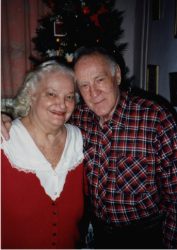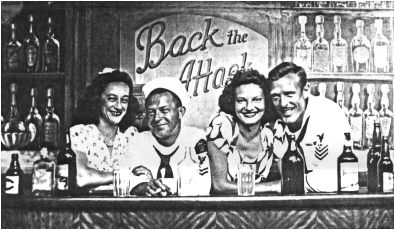
Left to right - Stella Strom, Joseph Strom ( Mare Naval base Cook) , Adele S. McKeever, James J. McKeever at Norfolk, VA 1945.
By James J. McKeever ( as taken from his notes transcribed by Paulette McKeever )
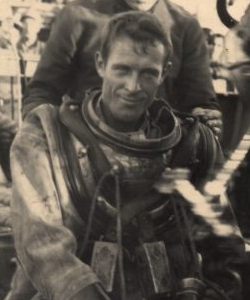
James
J. McKeever up after a 5 hour dive on Omaha Beach , Normandy France
, October 1944.
(2) When burning the superstructure on the Normandie, I was below another
diver who was burning the last hinge on a very heavy door. I told "Topside'
to let me know when he was almost finished but they did not. The armor-plated
door came down and missed killing me by inches. Luckily I felt it rumbling
down and hitting the ship's hull. I pushed my body away from that area
as it rumbled against my feet.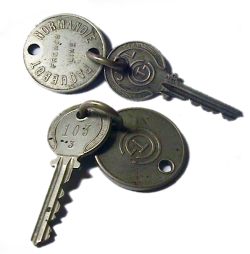
State room keys from the Normandie found underwater by James J. McKeever.
The following are James J. Mckeever's notes and memories about his dives
and experiences on the USS Diver and the Navy Salvage Training School.
They are typed here as written or told by him , without removing or
adding to the notes. In this sense, they aren't meant to be written
as stories , but as short notes about his experiences and memories.
(1) While working on the Normandie, I had to rush into my suit to rescue
a student diver who lost control of his air and almost went upside-down.
This would have flooded his suit and caused him to drown. I too almost
went upside-down because my belt was too high.
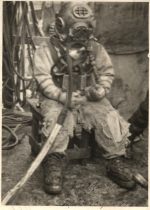
James J. McKeever suited up after a dive on the Normandy, March 10,1943.
The picture was taken on a float alongside the Normandy by pier 88 in NYC. They were cutting up the superstructure in order to lighten the ship , preparing to raise her.
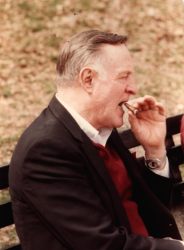
James J. McKeever , 1983
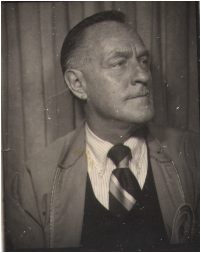 James J. McKeever |
The crew had placed a line from our ship to the stern of their ship and in the area of their propeller. I asked for a hydrogen torch to burn off the cable. While holding onto that line and the lit torch, I pulled myself over to the propeller I braced my legs over the back of the propeller shaft and hoped that the cable that was straining (due to the strong tide and the pull of the unanchored ship) would not snap at me.
After I had burned loose one end of the cable, I cut loose the other end and unwound the rest. When I felt the ship swinging loose, I took off like a jet to the safety of my ship. I was afraid they would start their engines and I would get chopped up by their propeller. When I climbed aboard the Diver, I received a heartwarming cheer by all the ship men and I was handed a chest-warming glass of alcohol since I was really freezing. It was great.
By the way, after I had cut the cable loose from the propeller, we started back to our base in England. When the sun rose, we noticed that the sky was filled with planes and as far as we could see, the Channel was packed with the Allied war ships. This was June 6 , 1944 , the start of the invasion of Normandy! We returned back to port but did not go to Normandy until about one week later.
Click here to listen to General Eisenhower's public radio broadcast on D-Day
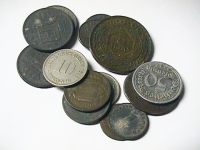
This handfull of German, French, Belgian and Morocco coins were found in a bunker at Omaha beach shortly after D-Day by James J. McKeever.
Years later, about 1965, I was watching a reunion on TV of veterans who had gone back to Normandy. One of the ex soldiers who was being interviewed said that he missed the primary landing because the ship that he was on was rescued by a Navy ship when his ship was struck in the channel. His ship went back to England and then later to Normandy. I wondered if this was the one that I had cut loose.
(4) In Le Havre, we were pumping air into a sunken freighter that was on its side and blocking the entrance to two piers. We blocked off all the portholes to contain some of the air that we were pumping into the hull. I was inside the freighter and covered up the last porthole. Another diver was outside the hull clamping the patch to contain the air. We were using air from the ship's compressor. I could seal the compartment full with air down to about three feet.
When the job was done, I started to come out, but when I went down to about four feet I did not have any air. I called up to the ship and told them my situation. The "Tender" checked and found that the engineering crew had shut off the ship's compressor. This was the "normal" procedure in the engine room because we rarely used that air since we normally had our diving boats. But in this case we had to use the large portable compressors to pump air into that freighter's hull which was to be moved by very large English lifting ships (large barges with large cables on their bow).
(5) I had another experience with a large octopus and a lost twenty-five horsepower outboard motor - it's a long story...
(6) There was a dive I made on an LST which had sunk due to a mine.
(7) Another diving experience was when I was diving on a sunken Army tug and my air valve got caught behind a door hinge. This mishap had shut off my air and for about five minutes I thought I was a goner since there was no diver suited above me. Luckily I was able to clear it and my air turned back on. I did not tell the crew.
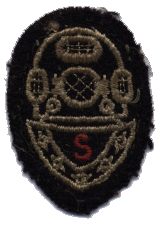
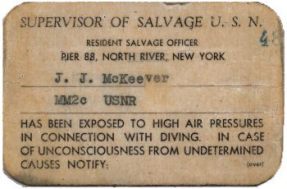
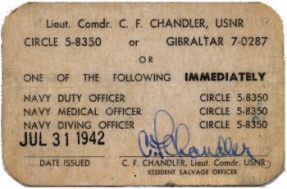

(1) Do any of you remember the lung tester that the school had? It was the brass container that you had to blow into which would turn a small fan on top of the tester. Of course the ones blowing into it did not know that the tube you blew into also had an inner blow pipe. One pipe would spin the fan on top but the other one would pass your air into the container that was full of lamp black. As your blowing turned the fan wheel, that same air blew lamp black on the blower's face. It was so fine that you would not realize that your face was getting black until you looked into a mirror or someone would tell you.
On my ship, the Diver, we made one and had a lot of fun testing anyone in the crew who wanted to see if they had the required lung power to be a diver like us. We would cheer them on to blow as long as possible. Just like Pier 88 they would be told to take a deep breath and keep blowing until they were out of breath. They were also told that all divers were able to turn that blade for a very long time without taking a breath and that was the main reason the divers were selected by the Navy. We even convinced some gullible fellows who later saw that their eye areas covered with black, that it came from the exhaust fan on the deck.
Some of the crew asked to try on the full full diving suit plus the weighted shoes and belt. We would let them walk through the ship's compartments while we had them talking and singing to see if they had the proper voice to be a diver.
One of the men even believed that one of our divers, while in deep water, had his foot trapped in the jaws of a giant clam. We told him that we had to send an air driven jackhammer to free his foot from that clam. We also told him that divers should not have any static electricity because when they used the Swafford electric torch, the static electricity emitted from their body along with the electric from the Swafford could electrocute them. Our "test" for static consisted of running a comb through the person's hair and if a piece of paper given to them would jump to the comb, the had too much static electricity. Unknown to him we would do it on ourselves in front of him but we used a pre-dampened paper and it would not attract to the comb. Naturally, the paper that we gave the person was a dry one.
(3) There were many episodes sleeping on Pier 88!
(4) A set of 120 lb barbells were brought to the pier by me. The chief on duty did not believe that I had these heavy barbells in my bag and ordered me to put the bag on his desk. When I did as he ordered, the chief's flimsy desk broke in half under the weight!
(5) There is my story about being assaulted by a student who was told that he could not stop for a doughnut outside pier 88 and what took place afterward.
(6) What decompression chamber meant to test future divers and what that test meant for them to qualify as I was told by instructors.
(7) When leaving Le Havre, the ship, the Diver hit a submerged wreck and could have sunk. It was patched up and repaired at a French shipyard.
(8) A Navy ship sank because I could not fill the pump's gas tanks while the engines were running. Commodore Sullivan told me to stop gassing up. We used Aviation fuel and the engines ran hot. I found out from experience that shutting down these engines that were so hot would not restart until they cooled up because of Aviation gas.
Also we had loaned the British four of our large pumps on their manmade harbor; each one was about the size of a city block. Well, they sank our pumps along with the units and we had to reclaim them. I had to dismantle all of the engines on the pumps and clean all moving parts and then put them back in place - using the fantail on our ship. We got them working again but I was always worried that the salt water would damage the magnetos, but they did not. By the way, these large cement units were designed to be used at the Normandy Beach for manmade harbors for unloading supplies for our troops.
(9) I have to tell you how lucky I was in getting into the Navy and diving school. I had served in the US Army from 1936 to 1939 in the First Division and in the 26th Infantry and later in the 16th Infantry. From there I got a job in a Staten Island shipyard as an outside mechanic.
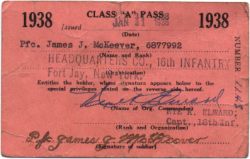
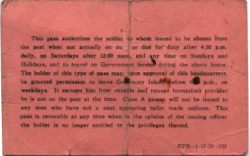
When the war broke out, I decided to join the Navy. I went to recruiting station and was put on a waiting list since they had no openings. While working in the shipyard, I was on a different list and could not be drafted. I resigned from that job, thinking that the Navy would shortly call me. In the meantime, I went to a minister who was in charge of my status. He told me to come back to him if the Army called me first. He said that he would hold me over until the Navy sent for me.
Well, I did get a notice from the Army to come down to Whitehall Street in Manhattan to be inducted into the US Army on April 15, 1942. I went back to the draft board and showed the minister my induction notice and reminded him of his promise. He told me it was too late and that he could not help me.
That same day I went back to the Navy recruiting office and showed them my draft notice from the Army. The officer in charge told me there was nothing that he could do. In the meantime he was looking at some papers that referred to my former visit in reference to my shipyard experience. There was also a letter of recommendation that I received from the Naval officer who was connected with that shipyard. On one one of the forms was some writing in large red words When he read what was written, he did not tell me what it said, but he told me not to worry because the Navy would induct me before the Army.
Sure enough, the Navy sent instructions to report to Pier 92 in the Hudson River on April 14, 1942 for duty; which I did. The next day, on April 6, Army MP's came to my house since I had not reported for my induction back into the US Army. I was now in the Navy at Pier 92 which my wife informed them. After that, I no longer heard from the Army. (Lucky for me since many of my old Army friends died in battle later on in the war. My Army training was for combat intelligence involving the making of field maps of forward combat positions which was worse than diving.)
(10) Do you remember when you were diving at the school, your normal dive was three hours underwater? Now this created a problem for me especially in the winter. My kidneys would be killing me until I got topside to retrieve myself. The rule in the school was: if you urinated in your suit while diving, it was your responsibility to turn your suit inside out and wash it with soap and hang it up to dry when you came up.
Well, I decided to make something to wear inside the suit in which you could relieve yourself, but not in the suit I got a piece of wire-reinforced hose, cut it about a foot long, sealed the bottom of it with canvas and rubber cement, stuffed half of it with rags, and put a harness on it that could be tied below the waist. I then tried it on one of my dives and it worked like a charm; my suit was dry. Later, I found that the more I wore it the less I had to make use of it. It was probably mind over matter, but it did help.
One of the other divers asked me to make one for him, which I did. The first time he used it he was only underwater a short time when he developed a pain - the wire at the lower end had caught on his penis. He no longer wanted to use it! The crew on my diving ship called it, "McKeever's Pissaroo".
(11) When I was down burning sections of a superstructure, I always got
a lot of river water pouring into my suit through the rubber bands we
used on the cuffs. This occurred especially when the crane hook came down
for me to connect it to the cut section.
You could not see that large hook but you could hear the water as its
pulley tuned to lower it down. It was not a pleasant sound to hear mainly
due to the fear of misjudging its location and getting your hand cut off
by the pulley.
(12) On an inspection dive of a sunken freighter which was laying on its
side, you could hear a sort of ticking noise at the bottom of the stern.
There was a large drum at that location; for a time we thought it was
a mine placed there by the Germans.
We later found out that it was just an empty fifty gallon drum. The sound
we were hearing was from pile drivers that Army engineers were using about
a mile or so from where we were diving. The sound of the pile driver carried
through the water. They were using the driver to build a pier.
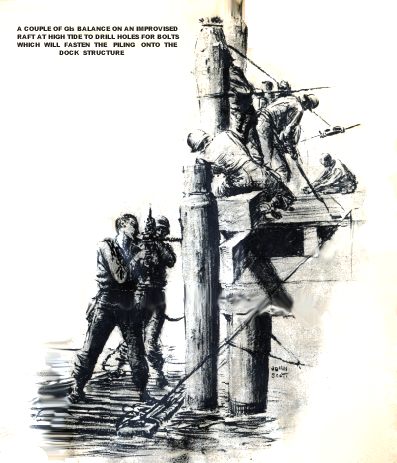
The above is a restored drawing by Sgt. John Scott , Yank Staff Artist from the April 20 , 1945 edition of Yank Magazine about Cherbourg. The caption reads : A couple of GI's balance on an improvised raft at high tide to drill holes for bolts which will fasten the piling onto the dock structure.
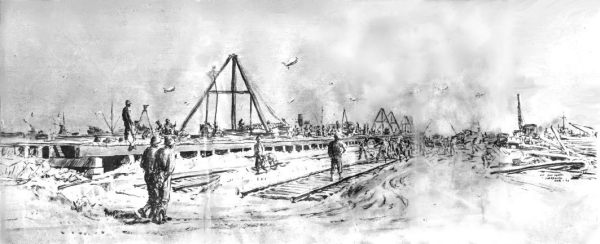
This
is another restored drawing by Sgt. John Scott from same edition of Yank
about Cherbourg. Notice the pile drivers in the background. The caption
says : Some of the miles of new dock space created by the engineers in
a few weeks in an area once occupied by nazi 88 anti-aircraft guns and
pillboxes. Concrete sides of the quay sloped outward at the bottom and
steel arms bristled with barbed wire at the top. The engineers provided
a vast wharf area by driving in piling and building out the dock from
the edge of the existing concrete. Here, cranes are being erected and
a railroad track is being laid.
(13) We also spent a few weeks near Loc Lohman, Scotland learning to use
plastic explosives but we never - at least I did not - use that experience.
(14) I also had one experience descending down a ladder to a section of
a partly sunken LST. Commodore Sullivan wanted to know if the crewman
on watch had dogged down a door leading to the shaft alley and if the
water that flooded the ship had come through that open door.
Since that area was full of fuel oil, the fear was that our gas mask and
air hose would allow oil to seep in. Whoever dove there would be in trouble.
Well, I climbed down that ladder to the surface of the oil and ran my
hand to it. To my delight, I found that the oil was only on the surface.
I descended down using my portable light to about twenty-five feet to
where that door was and there was a jagged hole in the side of the hull
where the water had entered. I then came up and told them about the hole
in the hull.
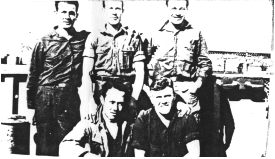
USS Diver crewmembers
(left to right , top) S.B. Murphy , James J. McKeever , W.E. Syrjala
(left to right , bot) R.F. Wilson , F.J. Quigley
I decided that I had to write a few more words to express my admiration for the divers who risked their lives in making those deep dives to discover the limit that we could safely dive in the suit. I also admire the divers who had to remove the dead bodies from sunken ships or work in areas where there were mines.
As a diver, I appreciate the work of Jacques Cousteau and his crews who taught us about the creatures living in our seas. The salvage divers deserve much praise because of the numerous dives that they have experienced.
This is the first time that I have ever written about my own experiences. When I heard about the divers convention in New London, Connecticut, it restored many of my almost forgotten memories. This in turn caused me to write about some of my favorites.
James J McKeever
A few more stories...
1) The story of the burning, capsizing and sinking of the Oceanliner Normandie
was told to me by civilians who were working at Pier 88 at that time.
The Normandie caught on fire while it was being converted into a troop
ship for the United States. This fire was accidentally started either
from a welding or an acetylene torch during construction. Many of the
hose fittings on that pier had been changed for the use of the French
who were using that pier. When NYC firemen tried to connect their hoses
they would not fit. By the time they got hoses connected, the fire started
to spread through the ship. City fire boats also came and used their water.
In the meantime, doors and hatches to lower compartments had been closed
to prevent the water from flooding the lower levels. When the fire was
finally considered out of control, someone decided to move the ship away
from the pier. When the lines were removed, the upper section which was
top-heavy with water, caused it to capsize and sink.
(2) In early 1943, most of the Divers crew were stationed in a barracks
at Mare Island Naval Base. Our ship was being constructed at the Basalt
Rock Company in Napa, California. My wife had mailed a $50 bill to me
as a down-payment for a cabin. She and her sister were coming out west,
along with my daughter, to be near me.
I had never seen a $50 bill and I showed it to the men who were stationed
in my barracks. I then put the money in my locker before I left with most
of the crew to do the various daily jobs When I returned later on and
looked in my locker, I found that the $50 was gone. It would have been
impossible for me to find out who did it If it were not for an accident
that happened a day later. One of the divers Danny Esposito, had purchased
a pair of shoes when he was in NYC. They too had been stolen but he had
found that one of the men in the barracks had them. Esposito got his shoes
back after proving they were his. When he heard about my loss he advised
me to tell the Chief Bosson's Mate in charge of our barracks, which I
did.
The next morning at muster, the chief came into the room accompanied by
a Navy Officer. The chief then told us that before he was drafted into
the Navy he was a detective on the Los Angeles police force and his specialty
was fingerprints. He said he was going to check all fingerprints on and
in my locker with powder and also the wallet. When he found the prints
other than mine, he was going to have those prints checked to see who
they belonged to and if they belonged to the thief, he would be spending
ten years in a Naval prison.
The following day, I found a note in my locker that contained five $10
bills and the words, "Thank you for the loan." When I told the chief what
he had accomplished and thanked him, he told me that he was not a detective.
He had made up the story - hoping it would scare the thief, which it did!
